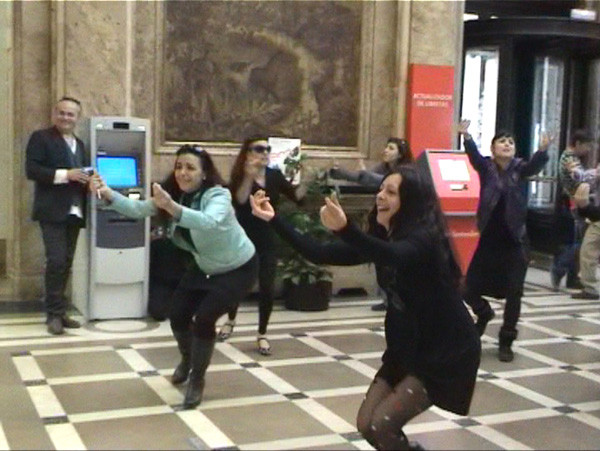An appropriated form for spectacular action
flo6x8 in 'It's the Political Economy, Stupid'

Before it closes, anyone around or passing through New York City should check out Oliver Ressler’s and Gregory Sholette’s exhibit at the Austrian Cultural Forum, “It's the Political Economy, Stupid.” Here is how the curators describe the show:
Today, the very idea of the modern nation state is in jeopardy as the deterritorialized flow of finance capital melts down all that was once solid into raw material for market speculation. This exhibition represents one response to this crisis. It derives its title from candidate Bill Clinton’s 1992 campaign slogan, “It’s the economy, stupid,” modified here by the Slovenian philosopher Slavoj Žižek.
It’s the Political Economy, Stupid brings together an international group of artists who use their work to critique 30 years of neoliberal globalization, privatization, flexible work schedules, deregulated markets, all of which have driven most of the world’s governments to wholly or partly abandon their previous role as arbitrators between the security of the majority and the profiteering of the corporate sector.
Rather than acquiesce to the calamity, we ask if it is not time to push back against the disciplinary dictates of capitalist logic and, by use of artistic means, occupy the very notion of the social itself.
Exceptional among the many exceptional works in the show is the Spanish group flo6x8’s video, Body Versus Capital (2011), which depicts the group taking up Flamenco for demonstration and protest against our current economic systems, and particularly the European banking system. Below is an excerpt from a short essay that will be published by the Indian art journal, Lalit Kala Contemporary Journal, this spring.
Dance is a metaphor that recurs throughout the exhibition. In [Isa] Rosenberger’s installation financial capital, and the erosion of public banking first in Europe and Eastern Europe in the 30s and now globally in our present, is imagined after [Kurt] Joos as a dance of death giving way to the fascisms which, as Brecht recognized, are capitalism’s counterpart. In yet another work, Linda Bilda’s sculpture Labor and Capital (2004), labor and capital are depicted as a shark and a ballerina engaged in a tango. As a plaque beside the work explains: “Capital always wants profit by any means and at the expense of labor.”
Dance emerges less as a metaphor, and more as an appropriated form for spectacular action, in the Spanish group flo6x8’s video, Body Versus Capital (2011), which compiles video of the group’s dancing and singing Flamenco in banks throughout Seville. This work, unlike any other work in the exhibit, documents a form of protest that I find extremely compelling for its tactical reappropriation of a traditional cultural form. Were the members of flo6x8 who perform these songs and dances not virtuosic, I do not think that their work would be nearly as successful. Harnessing the power of this cultural form native to Spain, which relies almost completely on the body (with the exception of basic prosthetics such as heel-toed boots and acoustic guitars) the group activates and agitates a social body. In one video from the compilation, we see a member of the group spill pennies on the floor of a bank then begin to dance over them. In another, no less than twenty dancers “swarm” a bank, forming rows and then a circle. Bank security guards seem at a loss about how to remove the dancers. At one point we see a security guard in pursuit of a dancer as she twirls away from him, continuing to dance.
Although the title of the work may suggest a Luddite sensibility, a withdrawal of the actual body from electronic protest, this is not the case as the video foregrounds the sophisticated ways that the group has mobilized social and popular media in their work. In their video they include footage of a David Letterman style late night program, in which the hosts poke fun at the protesters, dancing on bills instead of pennies. The talk show host explains that they can afford bills because they are on TV, an explanation that flo6x8 loop repeatedly, emphasizing the host’s swagger, if not also his complicity with regards to the financial system. Much of the footage also consists of surveillance camera footage, foregrounding the ways that the group uses media tactically to create spectacle.
SELF | LIFE | WRITING